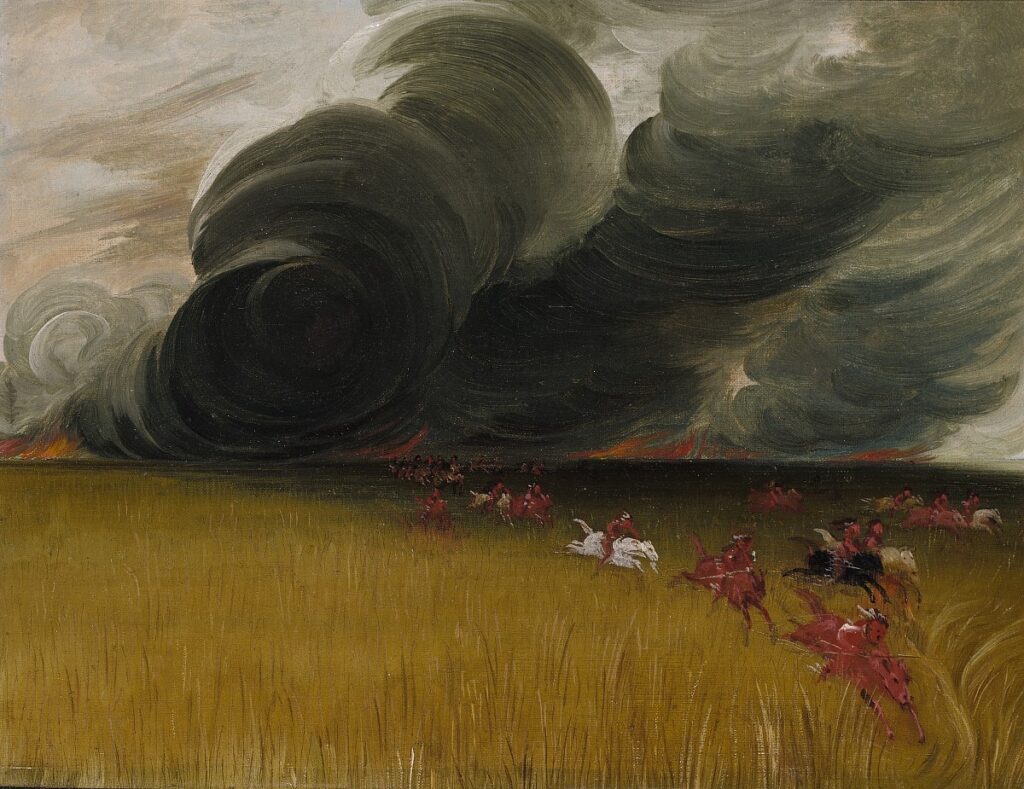Prairie Fires
By Eudora May Stone, age 13
ANNOTATIONS BY KAREN L. KILCUP

The autumn frost begins to blight,
But here and there late blossoms linger:
The maple leaves are glowing bright,
Red-painted all by Autumn’s finger.
The birds are gone; the chill wind grieves[1] But, see, a spark has fallen there Now, farmers, guard your hoarded grain; The sun sinks low, the waning light Now fiercer still the wild winds blow –
Among the dry and withered grasses,
And showers of gold or scarlet leaves
It flings from every tree it passes.[2]
Among the grasses of the prairie;
And high and higher in the air
The flames are leaping light and airy.
The flames are wider, fiercer growing,
And urging on the fiery train,
The raging wind is wildly blowing.
Is fading fast from hills and meadows;
The night, so strangely, grandly bright,
Mantles the earth in fitful shadows.
The sky the fiery color catches;
And brighter yet the red flames glow,
And wide the blackened prairie stretches.
St. Nicholas Magazine 1, no. 2 (September 1874): 629.
[1] Stone anthropomorphizes the wind, inviting readers to perceive it as having agency.
[2] The falling leaves add to the potential fuel of “the dry and withered grasses.”
Contexts
Prairie fires were common events in the nineteenth century, and they remain so today. According to History Nebraska, “The first settlers of Nebraska found a vast expanse of bluestem, which could be highly flammable. The danger was greatest during the late autumn of a dry season before the winter’s snows or after the snow melted during a dry spring. Smoke indicating a prairie fire was sometimes visible for days, and the horizon correspondingly illuminated at night. Fires sometimes originated as far away as Dakota Territory.”
The same source observes that fires were used as weapons against Native Americans. The U.S. Army set one historically large blaze in 1865 that consumed much of Nebraska and the Great Plains, as the federal government attempted to “drive Indians out of the Platte Valley.” Eudora Stone’s family members would likely have told her stories about this fire, which would have occurred around the time she was born.
In “Forces of Nature,” the Kansas Historical Society emphasizes how prairie fires are a natural part of the area’s ecosystem, but white settlers moving into the region did not understand fires as the Native Americans did: “American Indians had burned off sections of prairie for centuries. They realized that fire promoted the growth of new grass attractive to buffalo. But many farmers new to the Plains thought trees, not grasses, were a sign of the land’s richness. They believed prairie fires had created the Great American Desert by preventing trees from growing. Burning the prairie was considered uncivilized, and it threatened the houses, barns, and livestock settlers had worked so hard to acquire.”
Today, we consider controlled burns as essential to ecosystem health.
Resources for Further Study
- Julie Courtright, Prairie Fire: A Great Plains History (Lawrence, KS: University of Kansas Press, 2011).
- Christopher I. Roos et al., “Indigenous Impacts on Great Plains Fire Regimes of the Past Milennium,” PNAS: Proceedings of the National Academy of Sciences of the United States of America, August 7, 2018.
- Donald E. Westover, “Prairie Fires and the Nebraska Pioneer,” Digital Commons @ University of Nebraska-Lincoln, 1978.
- “Fire and Grazing in the Prairie: Tallgrass Prairie,” National Park Service, n.d.
Pedagogy
A number of midwestern teachers have developed lesson plans that teach children about prairie fires’ history and current significance; examples appear below.
- Laurel Smith and Dawn Hagan, “Fires on the Prairie” aims at younger children.
- “Prairie Fire,” North Dakota Studies, State Historical Society of North Dakota
Contemporary Connections
Writing for the National Oceanic and Atmospheric Administration in “Prairie Fires on the Southern Plains,” Deke Arndt writes about the fires that devastated large sections of the southern plains in 2016.